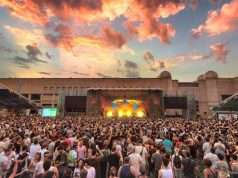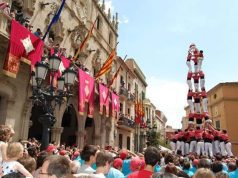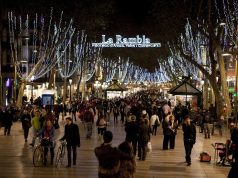Barcelona is a city full of attractions, culture and history, but there is one district that often goes unnoticed by tourists. Sants-Montjuïc district of Barcelona is located in the south of the city, and covers a large area. The neighborhoods of Sants, Hostafrancs, La Bordeta, Poble-sec, La Marina de Port, La Marina del Prat Vermell and Montjuïc form Sants-Montjuïc. It is a part of Barcelona that combines urban and natural landscapes, modern and traditional architecture.
In this blog, we will show you why you should visit Sants-Montjuïc and what you can see and do there. Also we will share some tips and tricks to help you make the most of your experience.
A District with History and Diversity
Sants-Montjuïc is a district that has a rich and varied history, as it was once a separate municipality that was annexed to Barcelona in 1897. It was also the site of important events such as the 1929 International Exposition and the 1992 Summer Olympics. Both of these events have left a legacy of buildings and infrastructure that can still be enjoyed today.
Sants-Montjuïc is also a district that reflects the diversity and multiculturalism of Barcelona, as it is home to people from different backgrounds, origins and cultures. You can find a mix of languages, cuisines and traditions in its streets, markets and festivals.

What to See and Do in Sants-Montjuïc
Sants-Montjuïc is a district that offers something for everyone, whether you are interested in culture, nature, sports or entertainment. Here are some of the highlights that you should not miss:
- Montjuïc: The hill that gives its name to the district and dominates the skyline of Barcelona. It is a green oasis that offers panoramic views of the city and the sea. There are many attractions to visit such as the Castle of Montjuïc, a 17th century fortress that was used as a prison and a military museum; the Palau Nacional, a majestic building that houses the Museu Nacional d’Art de Catalunya (MNAC), where you can admire works of Catalan art from Romanesque to modern times; the Magic Fountain, a spectacular show of light, water and music that takes place at night; the Poble Espanyol, an open-air museum that recreates different architectural styles from different regions of Spain; and many parks and gardens where you can relax and enjoy nature.
- Olympic Ring: The main area where most of the venues for the 1992 Summer Olympics were located, such as the Olympic Stadium, which hosted the opening and closing ceremonies; the Palau Sant Jordi, an indoor arena that hosted gymnastics, volleyball and basketball; the Olympic Swimming Pool, which hosted diving and water polo; and the Calatrava Tower, a communications tower designed by architect Santiago Calatrava. You can also visit the Olympic Museum, which displays memorabilia and information about the games and their athletes.
- Sants: The neighborhood of the district and one of the most authentic and lively areas of Barcelona. It is known for its industrial past, its working-class identity and its festive spirit. You can stroll along its main street, Carrer de Sants, which is one of the longest shopping streets in Europe; visit its market, Mercat de Sants, which offers fresh produce and local products; or join its annual festival, Festa Major de Sants, which takes place in late August and features decorated streets, concerts, dances and fireworks.
- Poble-sec: This is another neighborhood of the district that has a lot of charm and personality. It is located at the foot of Montjuïc and has a bohemian and artistic vibe. You can find many theaters, bars, restaurants and cultural venues, such as the Teatre Grec, an open-air theater that hosts performances during the summer.
Tips and Tricks When Visiting Sants-Montjuïc District
- Sants-Montjuïc is a large and diverse district, so it is advisable to plan your visit according to your interests. You can use public transport, such as buses, metro or trains, to move around the district. A better way of exploring the area is to rent a bike or walk if you want to enjoy the scenery.
- You will find many activities and events throughout the year, so it is worth checking the calendar before you go. You can find festivals, concerts, exhibitions, markets and more that will make your visit more enjoyable and memorable.
- The district offers a lot of local flavor and character, so it is a great place to experience the authentic Barcelona. You can mingle with the locals, try their cuisine, learn their traditions and discover their secrets.
How To Get To Sants-Montjuïc District Of Barcelona.
Here are some of the main public transport options that you can use to get to and around Sants-Montjuïc:-
Metro: The metro is one of the fastest and easiest ways to get to and around Sants-Montjuïc. There are several metro lines that serve the district, such as L1 (red), L2 (purple), L3 (green) and L9 (orange). You can use the metro to get to places such as Plaça de Sants, Plaça d’Espanya, Paral·lel, Poble-sec or Zona Universitària. You can also use the Funicular de Montjuïc, which connects Paral·lel station with Montjuïc Park. The metro runs from 5 am to midnight on weekdays, until 2 am on Fridays and all night on Saturdays. You can buy single tickets or multi-trip cards at the stations or online. For more information, visit the official website of TMB (Transports Metropolitans de Barcelona).-
Bus: The bus is another convenient and affordable way to get to and around Sants-Montjuïc. There are many bus lines that cover the district, such as 46, 55, D20, D50, H16 or L86. You can use the bus to get to places such as Sants Station, Montjuïc Castle, Poble Espanyol or Olympic Stadium. The bus runs from 4:30 am to 11 pm on weekdays, until 2 am on Fridays and Saturdays and all night on some lines. You can buy single tickets or multi-trip cards on board or at vending machines. For more information, visit the official website of TMB (Transports Metropolitans de Barcelona).-
Train: The train is another option to get to and around Sants-Montjuïc. This is especially true if you are coming from outside Barcelona or want to visit other nearby cities. There are two main train stations in the district: Sants Station and Barcelona-Estació de França. Sants Station is one of the main hubs of the city, where you can find high-speed trains (AVE), regional trains (Rodalies) and suburban trains (FGC). You can use the train to get to places such as Plaça de Catalunya, El Prat Airport or Tarragona. Barcelona-Estació de França is a smaller station near the port, where you can find regional trains (Rodalies) and long-distance trains (Renfe). You can use the train to get to places such as Girona, Figueres or Valencia. You can buy tickets at the stations or online. For more information, visit the official websites of Renfe and FGC.
Bike: The bike is another option to get to and around Sants-Montjuïc. Probably the best way if you want to enjoy the scenery and exercise. There are many bike lanes and paths in the district that allow you to cycle safely and comfortably. You can use the public bike service Bicing, which has many stations in the district where you can pick up and drop off bikes. You need to register online and pay a fee to use Bicing.
Conclusion
Sants-Montjuïc is a part of Barcelona that deserves more attention and recognition. It is a part of the city that combines history and modernity, nature and culture, diversity and identity. It offers something for everyone, whether you are looking for culture, nature, sports or entertainment.













